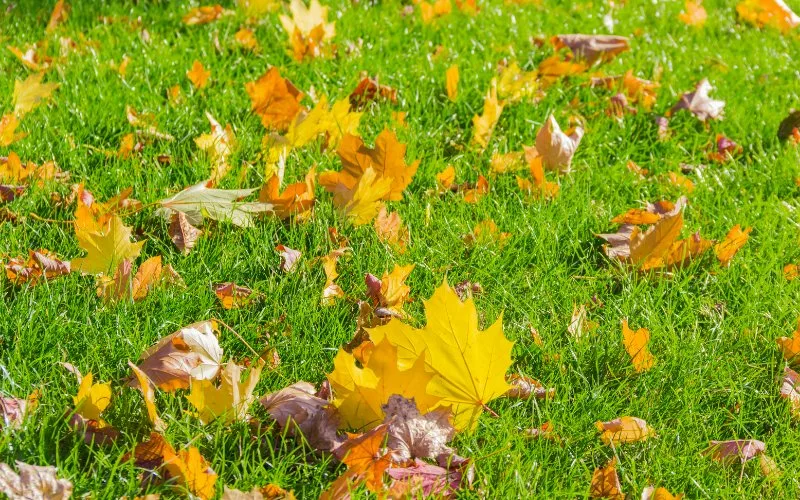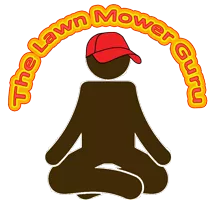A lot of people hate the fall because they associate it with raking leaves. Hours of back-breaking work, toiling to get your yard looking somewhat respectable once more. There must be a better way, right?! Well, there is. Mulching leaves with a lawn mower is a great alternative that will not only save you from all that bending over, but it will also provide your lawn with a number of benefits.
By mulching leaves, I’m referring to the process whereby you use your lawn mower to cut them into minute little shreds that are spread over the surface of your lawn, which then decompose naturally after a short time.
Sound good? I thought so! All you need is a mower capable of mulching (although you can mulch leaves without a mower) and a bit of know-how, which I’m going to provide you with in this article.

Why You Should Mulch Leaves with a Lawn Mower
Before I get stuck in with the tips and tricks to help you mulch leaves more effectively with a lawn mower, I just want to touch on a few of the key reasons for giving up the rake and dealing with your leaves in this manner instead. People often ask me “is mulching leaves good for your lawn?” My response: YOU BET IT IS!
- Mulching is easier on the back, as you cut out all that bending down to collect the leaves.
- It’ll improve the health of the soil, which in turn leads to a healthier lawn.
- It’s remarkably quicker than raking leaves.
- Better for the environment – bagged leaves go to landfill, mulched leaves don’t.
- Saves you money on fertilizer and other products from the store.
In short, mulching leaves with a lawn mower is a win-win all round. For your own health, your lawn’s health, your finances and for the planet. It’s not so often that all of those things align!
A Few Things Before You Start
My wife always tells me that “I’m too square” and it’s definitely true that I prefer to follow a methodical routine every time I mow. It helps me to avoid doing anything stupid (most of the time). Anyway, here are a couple of things I think you would be wise to do before you start.
Check for Hidden Objects
No, your lawn hasn’t been converted into the set of a cool new game show. BUT, if you’re dealing with a good covering of leaves, there could be some “surprises” hidden beneath the surface.
And if those surprises turn out to be a rock or another hard object, running over them with a mower isn’t a great idea. It can actually seriously damage your mower, with a bent blade or crankshaft the likely result (I’m guilty of making this mistake).
That’s why I always pace up and down my lawn before I fire my mower up. I use my feet to feel under any spots that are completely covered over by leaves, and remove anything that I find. (Dog toys are a pretty common find in my case.)
Set the Right Cutting Height
The best mower height for mulching leaves is something a lot of people struggle with. Some set it far too low, which ends up compacting all of the leaves, overloading the engine or motor, and results in very slow progress. Then others set it very high, which isn’t as bad, but often only results in a fraction of the leaves actually getting mulched.
It does depend somewhat on how many leaves you’re dealing with, the type of grass you have, and a few other factors, but I’ve found that somewhere between 2.5 and 3 inches generally works well for me. There’s enough contact, but the cutting deck (and consequently the engine) is not overloaded with leaves.
If when you start, you see your mower is struggling, stop and raise the deck to the next setting. React to what you see happening.

Mulching Leaves with a Lawn Mower Effectively
There’s mulching leaves with a lawn mower, and then there’s mulching leaves with a lawn mower properly. Through lots of trial and error, as well as learning from others, I’ve picked up some tips that can make this practice a lot more efficient.
Mulch Your Leaves Little and Often
Let them pile up and they won’t mulch so well. If you’ve ever tried to walk over a lawn that is covered in a thick layer of fallen leaves, it’s hard going, right?! It’s the same for your lawn mower. Trying to mulch that many leaves at once puts an awful lot of strain on the engine. If you’ve got a cheaper mower with a weaker engine or motor, you can forget it. It’ll continually bog down.
Why make life difficult for yourself when you don’t have to? Instead of waiting for all of the leaves to drop and dealing with them in one mammoth session (which will make you hate the experience most likely), take out your mower and mulch leaves once or twice per week through the fall. That way, you’ll always be mulching a manageable amount.
Another reason to mulch your leaves often is because the longer you leave them on the lawn, the less benefit your lawn will receive when you finally do mulch them. This is because their mineral value is lost through leaching over time. This mineral value is at its highest just after they fall to the ground.
Dry Leaves Mulch Infinitely Better
I can’t stress how much of a nightmare mulching wet leaves is. It’s honestly horrendous. If you think mulching wet grass is bad, damp leaves is next-level stuff.
Wait for a dry day and check the leaves are completely dry before you decide to have a mulching session. Dry leaves mulch extremely well and break down into very small particles very easily, which is exactly what you want.
Be Prepared for Multiple Passes
If you want to mulch leaves properly, it’s likely that you’ll have to go over them multiple times, particularly if you have a good covering of leaves. They’re not going to break down into small enough pieces on the first pass, so going over them 2 or even 3 times can be necessary.
If this makes the whole thing seem like more of a chore, just remember that the more you break down the leaves, the quicker they will decompose and start providing nutrients to your lawn.
Go Slower Than Normal
It can be tempting to tear right through a lawn covered in leaves, particularly if you’re on a ride-on mower or you have a self-propelled mower, but a steadier pace really is your friend when mulching leaves. You see, your mower really needs that extra time to put the leaves through the cutting cycle again and again to ensure they are as small as possible. If you go faster, you make it rush its work. So the slower the better in my experience. That’s how you get really good mulch.


Hi Tom,
And thanks for the leaf mulching tips. One question: do you think it is better to cover up the grass chute, or leave it open for normal discharge- when mulching. Thanks forany ideas, karl
Hi Karl. My recommendation would be that the grass chute should be covered when mulching. Just make sure you take it nice and slow. If the chute is left open, the grass and leaves will be discharged while they are in larger pieces than they would be if the chute were covered. The smaller the pieces of grass and leaves, the faster they will break down. Covering the chute will also lead to a more even distribution of the mulched material. I hope that helps 🙂
My mulching mower seems to push or blow the leaves forward more than it does suck them up and mulch. How can I fix that?
Hi Dave!
I’m sorry to hear that mulching hasn’t gone as you expected. Several factors can cause a mulching mower to behave unexpectedly. Below are a few things you can check or adjust to get things to work how they should.
1. Check to make sure that the deck of the mower is clean. Even 1/2″ of buildup can cause a mulching mower to refuse to take in the leaves.
2. Check to ensure that the right blades are attached. Mulching blades typically have a distinct, notched shape that helps cut through debris and prevent leaves and small particles from blowing around.
3. If the right blade is attached, it may be upside down. Mulching blades need to be attached in a certain way so that they “pull” instead of “push”. The side that needs to go “up” should be marked on the blade. If not, the tabs or “wings” should be pointed up, as a general rule.
4. Ensure that the blades are sharp. Dull blades won’t mulch leaves as much as they will cause them to clump under the mower causing a clog that can result in this type of leaf-pushing situation.
5. Check to make sure that the deck is level and at an appropriate height. Most lawnmower decks can be adjusted for both height and tilt though how you can adjust these things will depend on the model of mower you have.
6. Depending on your mower, you may need to add a small wedge to the chute where the bag is attached in order to balance the airflow. Most mulching mowers include a small, plastic, wedge-shaped accessory for this purpose.
7. It is normal for some leaves, especially fresh or wet leaves to escape the mower but you should still get the majority of them in the first pass. Mulching all of the leaves on a lawn may take more passes than you’re used to but the results are usually worth the extra effort.
I hope one of these suggestions helps you solve your leaf-mulching problem!
Cheers, Tom.
Is it OK to mulch Oak Leaves into your yard. If not, how should you handle them?
Hi Jack,
Throughout the year, I would say it’s fine because the oak tree shouldn’t be dropping too many leaves to overwhelm the grass. But when it comes to fall, I suggest picking them up and getting rid of them. The amount of leaves dropped during the fall will act as a blanket and suffocate the lawn, even if you cut them up with the mower. Another idea is to compost the oak leaves with other organic matter and use it down the line, say in a few months when the compost is ready.
Thanks for your comment,
Tom.
I see recommendations advising against mulching wet leaves. Perhaps it’s a toss wet or dry leaves. Wet leaves create less dust and are heavy creating less mower deck throw out and more multiple cut leaf fragments.
Hi David,
In my experience, it’s really down to what lawn mower you are using. If you have a big mower with multiple blades, then wet leaves are not such a problem. But if you are using a small single-blade lawn mower, then it can get clogged up pretty quickly and bog down with wet leaves. That being said, you are definitely right when it comes to the amount of dust created by cutting dry leaves. Sometimes it’s like mowing in a cloud.
Thanks for the comment.
Tom.